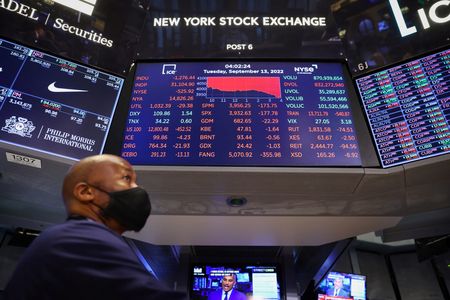
By David French
(Reuters) – Wall Street slumped more than 2% on Friday as investor concerns about the health of the American economy and the impact of the U.S. Federal Reserve’s aggressive interest rate policy to quell inflation triggered a sell-off.
The Dow slipped down more than 20% from its Jan. 4 record all-time closing peak of 36,799.64 points. A close of 20% or more below that level would see the blue-chip index attain a bear market label, according to a widely used definition. The S&P 500 and the Nasdaq are already in a bear market.
The S&P 500 and the Nasdaq are also closing in on mid-June lows – their weakest points of the year – with the former benchmark index now around 0.6% away from that grim milestone. The Dow is trading at November 2020 lows.
After enjoying hefty gains for last two years, Wall Street has been rocked in 2022 by worries about a host of issues including the Ukraine conflict, the energy crisis in Europe, China’s COVID-19 flare ups, and tightening financial conditions across the globe.
A half dozen central banks including in the United States, Britain, Sweden, Switzerland and Norway delivered rate hikes this week to fight inflation, but it was the Fed’s signal that it expects high U.S. rates to last through 2023 that caught markets off guard.
“There had been some optimists out there saying that inflation may be coming under control but the Fed effectively told them to sit down and shut up,” said David Russell, VP of market intelligence at TradeStation Group.
“The Fed is trying to rip the band-aid off, trying to kill inflation while the jobs market is still strong.”
Dire outlooks from a handful of companies have also added to woes in a seasonally weak period for markets. Having withdrawn its earnings forecast last week, FedEx Corp outlined on Thursday cost cuts of up to $2.7 billion after falling demand hammered first-quarter profits.
The delivery giant’s stock slumped 5%, putting it on course for its lowest close since July 2020.
The S&P 500’s estimated earnings growth for the third quarter is at 4.6% down from 5% last week, according to Refinitiv data.
Goldman Sachs cut its year-end target for the benchmark S&P 500 index by about 16% to 3,600 points.
By 2:24 p.m. ET (1824 GMT), the Dow Jones Industrial Average fell 707.5 points, or 2.35%, to 29,369.18, the S&P 500 lost 94.67 points, or 2.52%, to 3,663.32 and the Nasdaq Composite dropped 285.52 points, or 2.58%, to 10,781.29.
All the three indexes were set for sharp weekly losses.
All the 11 major S&P sectors declined, led by a 7.1% slide in energy shares. Oil and gas-related stocks were pummeled by the decline in crude prices, which fell in response to concerns about demand in a recessionary environment and the strong U.S. dollar. [O/R]
Oilfield services were particularly hit, with Halliburton Co, Schlumberger and Helmerich and Payne Inc slumping between 9.5% and 11.7%.
Rate-sensitive technology and growth stocks dropped with Alphabet Inc, Apple Inc, Amazon.com, Microsoft Corp and Tesla Inc down between 2% and 4.7%.
Shares of Costco Wholesale Corp shed 4.5% after the big-box retailer reported a fall in its fourth-quarter profit margins.
The CBOE volatility index, also known as Wall Street’s fear gauge, rose to a three-month high of 31.53 points.
(Reporting by Ankika Biswas and Devik Jain in Bengaluru and David French in New York; Editing by Marguerita Choy)

